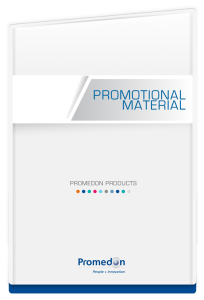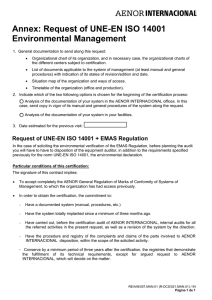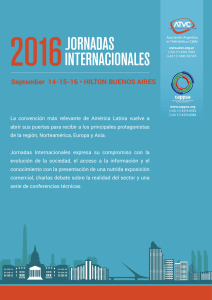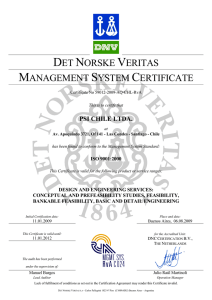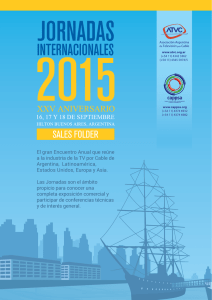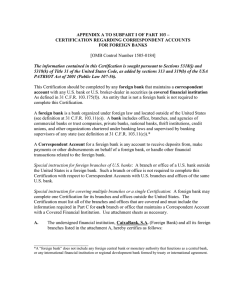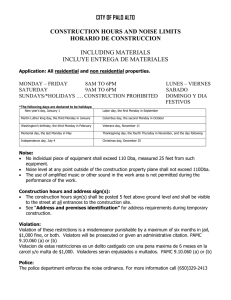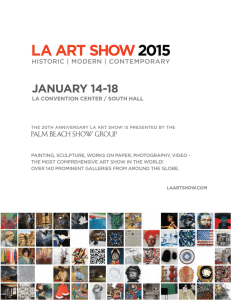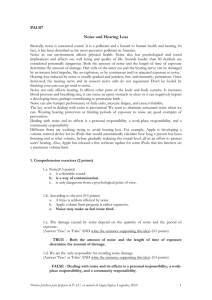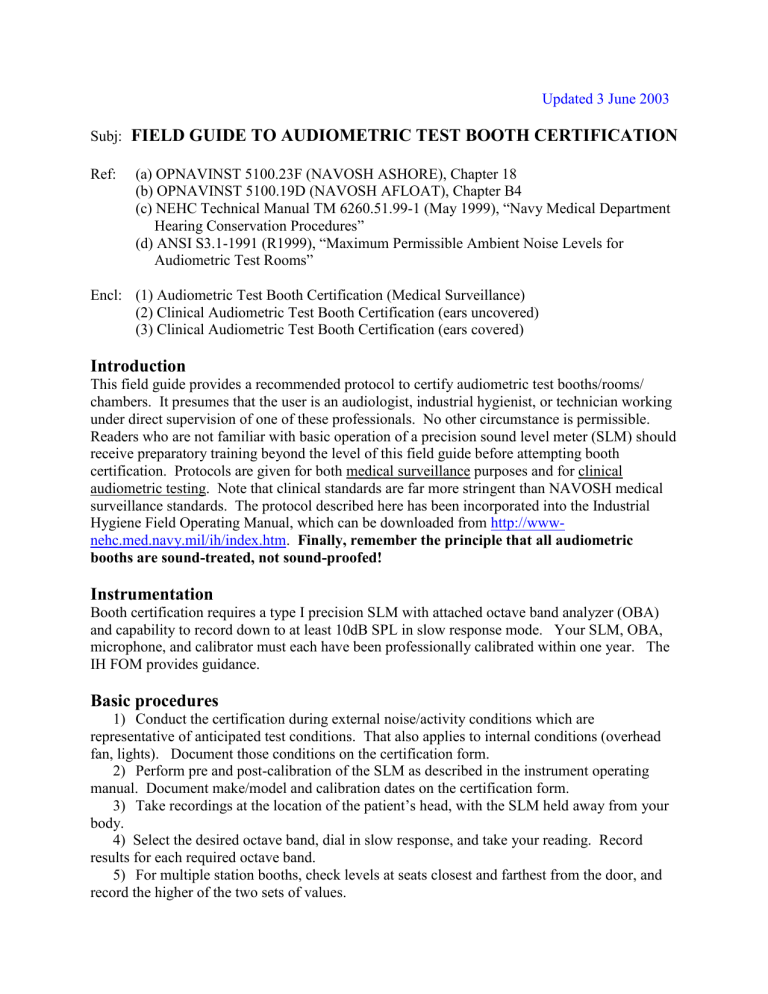
Updated 3 June 2003 Subj: FIELD GUIDE TO AUDIOMETRIC TEST BOOTH CERTIFICATION Ref: (a) OPNAVINST 5100.23F (NAVOSH ASHORE), Chapter 18 (b) OPNAVINST 5100.19D (NAVOSH AFLOAT), Chapter B4 (c) NEHC Technical Manual TM 6260.51.99-1 (May 1999), “Navy Medical Department Hearing Conservation Procedures” (d) ANSI S3.1-1991 (R1999), “Maximum Permissible Ambient Noise Levels for Audiometric Test Rooms” Encl: (1) Audiometric Test Booth Certification (Medical Surveillance) (2) Clinical Audiometric Test Booth Certification (ears uncovered) (3) Clinical Audiometric Test Booth Certification (ears covered) Introduction This field guide provides a recommended protocol to certify audiometric test booths/rooms/ chambers. It presumes that the user is an audiologist, industrial hygienist, or technician working under direct supervision of one of these professionals. No other circumstance is permissible. Readers who are not familiar with basic operation of a precision sound level meter (SLM) should receive preparatory training beyond the level of this field guide before attempting booth certification. Protocols are given for both medical surveillance purposes and for clinical audiometric testing. Note that clinical standards are far more stringent than NAVOSH medical surveillance standards. The protocol described here has been incorporated into the Industrial Hygiene Field Operating Manual, which can be downloaded from http://wwwnehc.med.navy.mil/ih/index.htm. Finally, remember the principle that all audiometric booths are sound-treated, not sound-proofed! Instrumentation Booth certification requires a type I precision SLM with attached octave band analyzer (OBA) and capability to record down to at least 10dB SPL in slow response mode. Your SLM, OBA, microphone, and calibrator must each have been professionally calibrated within one year. The IH FOM provides guidance. Basic procedures 1) Conduct the certification during external noise/activity conditions which are representative of anticipated test conditions. That also applies to internal conditions (overhead fan, lights). Document those conditions on the certification form. 2) Perform pre and post-calibration of the SLM as described in the instrument operating manual. Document make/model and calibration dates on the certification form. 3) Take recordings at the location of the patient’s head, with the SLM held away from your body. 4) Select the desired octave band, dial in slow response, and take your reading. Record results for each required octave band. 5) For multiple station booths, check levels at seats closest and farthest from the door, and record the higher of the two sets of values. 6) Record external levels for information value only. Levels will typically be quite variable, so you may prefer to simply record typical dBA and dBC levels. 7) At some point during the process, advise you have someone talk outside the booth to see if the booth is certifiable under that condition. Experience has shown that the most troublesome external noise source is a chatty audiometric technician. If external conversation precludes valid testing, be sure to annotate that fact on the certification form. This will often be the case with single-wall booths. 8) Record all values; complete and post the certification on the exterior of the booth or on an adjacent wall. Keep a copy for your files. Medical Surveillance References (a) and (b) describe NAVOSH responsibilities for Shore and Afloat commands, respectively. Each instruction refers to reference (c) for specific guidance in Medical Department aspects/responsibilities for the Hearing Conservation Program (HCP). Enclosure (1) is a medical surveillance booth certification form, with allowable background noise levels annotated. Click here for download. Periodicity. All audio booths require, at minimum, annual certification (365 day interval). A booth is certified for use during the exterior and interior conditions which prevailed at the time of certification. For example, a shipboard booth that has been certified pier-side cannot be utilized underway until it has been evaluated under representative underway conditions. Similarly, a booth must be re-certified if a fan becomes noisy, a persistent new exterior noise source is added, if the booth is re-located, or if there is any change in environment that has the potential to affect test results (i.e. results in interior ambient noise levels in excess of the allowable). Mobile Hearing Conservation Audiometric Trailers/Vehicles (MOHCATs/MOHCAVs) are a special situation. As mentioned above, a MOHCAT or MOHCAV booth requires annual certification the same as stationary booths. This is best accomplished in the location most often used (your major customer). If testing is to be conducted with on-board generators supplying power, then certification should be duplicated under that condition. Re-certification is also required whenever external conditions change – such as moving to a new location. It may not be practical to conduct a formal booth re-certification after each move, particularly for short-term, frequent deployments. The current model MOHCAVs were designed to incorporate a second wall of attenuation in the form of the body of the vehicle, and this works fairly well. However, noise sources such as cross-traffic, generators, flyovers, and small crafts pier-side all have the potential to invalidate test results. Here are two alternatives to formal recertification which will ensure test validity: 1) Conduct and document booth certification at each prospective test location, under worst-case test conditions. You need not repeat the certification for subsequent deployments to the same location. 2) When this is not feasible, a second option is to conduct a “biological” certification at a new test location prior to seeing patients. Conduct and retain an audiogram on a normal hearing listener to demonstrate a certifiable test environment. Assuming good hearing sensitivity by the listener, ambient noise should permit thresholds 0-5dB at 500 Hz, and 0dB at 1000 Hz and above. This could be called the “Golden Ear” method A knowledgeable and conscientious audio tech will pause the test when some noisy, transitory external event is occurring. Single-wall booths may not adequately attenuate an F-18 flyover or someone walking by with a boom box turned to max. Clinical Audiometric Testing Reference (d) describes the maximum permissible ambient noise levels (MPANLs) within a clinical audiometric test booth. MPANLs vary with test format, such as ears uncovered or covered, the frequency range to be tested, and whether the sound sampling strategy included octave band or one-third octave band measurements. This field guide presumes octave band SLM measurements and clinical pure tone testing in a frequency range of 250 to 8000 Hz. Enclosure (2) is a clinical booth certification form for personnel desiring to conduct sound field warble tone testing (ears uncovered). Click here to download. Enclosure (3) is a certification form for those conducting ears covered testing only, to include testing under headphones and using insert earphones. Download it here. The ears covered MPANLSs are considerably more lenient at low frequencies. The complete ANSI S3.1-1999 can be ordered on-line at http://www.ansi.org/ Troubleshooting 1) If a booth will not certify in low frequencies, re-check ambient levels with the fan turned off. If fan noise is determined to be the problem, then initiate repair immediately. Replacement of the fan is typically required, as most of them are sealed units with no first echelon maintenance. It is poor customer service to use a booth with an inoperable fan, whether you are in Keflavik or Key West. 2) Electrical lighting will occasionally be a source for low frequency noise in the form of 60-cycle hum, with harmonics migrating into the 500 Hz test range. This can be corrected. Do not make your customers sit in a dark room to take their hearing tests. It is unprofessional and encourages napping. 3) Door seal problems are common after several years of use. The seals harden, wear out, and must be replaced. Sometimes the door has been improperly hung, or develops a problem and must be shimmed carefully. A properly hung door will slowly swing shut by itself. A properly sealed door will offer light resistance to a dollar bill that is pulled through the seal anywhere along the periphery. 4) The jack panel is a recurring source for ambient noise interference. Some booths simply pass headphone and handswitch wiring though a hole in the jack panel. Sound attenuating material should be carefully packed around the wiring to seal the opening. The jack panel is also a good place to start when troubleshooting intermittent biological calibration difficulty. Biomedical repair personnel should be contacted to do continuity checks and clean/replace jacks and plugs as needed. 5) If the above actions do not adequately reduce ambient noise, options include removing/relocating external noise sources, relocating your booth, adding vibration dampers aboard ship (no simple task; talk to NAVSEA), or look for a replacement. Life cycle for an audio booth is largely dependent on the number of times it has been moved. More than 2 or 3 take down/reassemble evolutions renders most booths not worth the trouble. A reasonable life cycle for a stationary booth is 15 to 20 years, assuming routine maintenance of door seals and fans. 6) Plan on a double-wall booth in high traffic areas, aviation environments, or aboard ship. Remember that even a single-wall 1-man booth weighs 1800-2000 pounds, and a double-wall weighs (and costs) about twice as much. Consult an engineer to confirm that the floor can support the total weight of your booth and patient(s) in the selected location. 7) Finally, internal noise sources can be as problematic as external noise. Chairs or stools should be of sturdy metal construction that will not squeak, such as prison industries types. Curtains between multiple test stations will muffle sound and inhibit distractions. Carpeting or rubber mats further dampen noise. For further information or assistance…. Contact your area/regional audiologist or industrial hygienist for further assistance, or contact the Navy Environmental Health Center Hearing Conservation/Audiology Team at DSN 3770772/0773, commercial (757) 953-0772/0773, e-mail hearing@nehc.mar.med.navy.mil.
